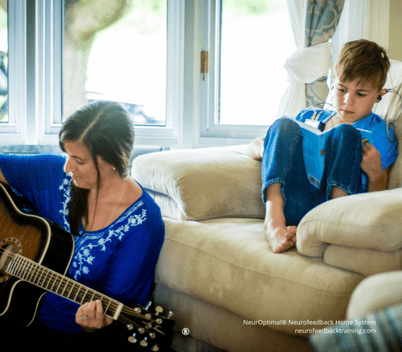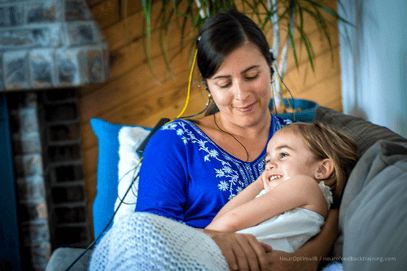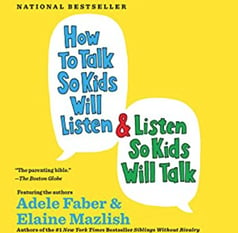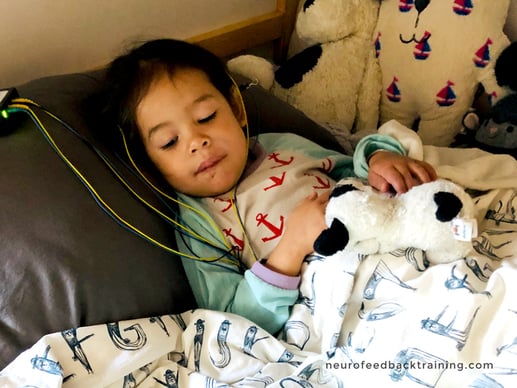Neurofeedback training with the NeurOptimal neurofeedback system can promote the wellness of the entire family. The benefits are many, feeling more calm, less stressed-out and feeling more alert. But to get the best results takes time some effort. Here are 4 ways to boost your results when a child is training their brain with the NeurOptimal system at home.
How to get Best Results With Neurofeedback At Home
1. Train Together – The More The Merrier!

If you live together also train your brains together! This can do a few things; training multiple people in the home at the same time help regulate all your nervous systems together. If a parent is feeling calmer and more flexible, the child too will feel that from the parent and from their own feedback. It also helps minimize any stigma around the training for a child. It can also be fun for the child to help Mom or Dad put on the sensors just like you help your child. This builds extra bonding time around helping each other and the experience of neurofeedback.
Why do we recommend that a parent also train?
Your child’s brain/central nervous system (CNS), is learning to assess current needs from gathering information in the here-and-now, rather than using habitual information/neural pathways. A major shift through training is your child’s brain learns to be in a state called regulation: calm, alert, and open to the here-and-now, and only become active only when there is an event that needs action.
 This process of learning is sped up when a primary caregiver’s brain is also learning the same process of being regulated–calm, centered, open. Why? Because just like you see in pack animal behaviors, children’s brains tune themselves to their caregivers’ brains. If the parent is nervous and worry a lot, the child will also become a "worrier". If the parent becomes calm the child’s brain will also shift, like tuning forks resonating with each other. A wonderful example of this process of attunement is to watch The Dog Whisperer on National Geographic. In the episodes you will see examples of how Cesar (the alpha dog trainer) who is “calm assertive”, i.e. has a regulated CNS, works with an agitated/fearful/aggressive dog through the natural attunement process where a beta dog’s CNS aligns with an alpha’s CNS.
This process of learning is sped up when a primary caregiver’s brain is also learning the same process of being regulated–calm, centered, open. Why? Because just like you see in pack animal behaviors, children’s brains tune themselves to their caregivers’ brains. If the parent is nervous and worry a lot, the child will also become a "worrier". If the parent becomes calm the child’s brain will also shift, like tuning forks resonating with each other. A wonderful example of this process of attunement is to watch The Dog Whisperer on National Geographic. In the episodes you will see examples of how Cesar (the alpha dog trainer) who is “calm assertive”, i.e. has a regulated CNS, works with an agitated/fearful/aggressive dog through the natural attunement process where a beta dog’s CNS aligns with an alpha’s CNS.
Neurofeedback review from a parent
Here's a review from a client who rented for two months and trained together as a family:

"I'm very glad to have found this tool. After two months of training I found there was a background of calm in our household. My 12 year old child wasn't always happy to sit still and do the sessions - (he was training the most of us, about 2-3 times per week), but as he gradually noticed his response to difficult emotional situations around his friends or school work he ended up wanting to do the sessions, so we rented for another month. As a working mother, I too found it was helpful and noticed I didn't become as triggered in those situations I previously would be triggered by. I highly recommend renting and train with the whole family!"
Can I train neurofeedback when I’m pregnant?
Yes, absolutely. One important aspect to know about true neurofeedback devices such as NeurOptimal is that nothing is added to your system and therefore it's 100% safe. To learn how it works, and what sets NeurOptimal apart from other neurofeedback devices, see this page. Our NY neurofeedback trainer also did neurofeedback while pregnant and we created this video where she discuss the positive effects of neurofeedback training.
Related:
2. Commit to the training and train regularly


Who's the boss? Parents are! In my opinion, parents are doing their best for their child and family and also know their child better than anyone. It's important to give kids options and choices but if you have determined that your child could benefit from neurofeedback, then the most important thing is to make sure your child trains and trains regularly throughout your rental. You would be surprised how many times we hear "My child didn't want to train today" or "He just doesn't like it". Let's be honest, children don't like a lot of things such as for example broccoli, homework, or dentist visits but they still need to experience those things. The same goes for neurofeedback training!
The only way to find out if this will work for you and your family is if you commit to doing it. To get the support around this topic as a parent, I recommend reading these two books; 123 magic by Dr. Tom Phelan and How to Talk so Kids Will Listen by Adele Faber and Elaine Mazlish. Watch also some parenting tips on the author's website. Classic parenting tips for all ages!!
3. Find the right time for the neurofeedback training at home

Scheduling can always be a challenge for a family. Depending on how your child feels during and after session you may want to consider when they train. Many adults and children feel relaxed or even sleep during a session. If that is the case, set up a session before bedtime. If your child falls asleep no problem, Simply unhook them and remove the extra remaining paste on the scalp and ear in the morning. Ask also your child when they want to train (before school, after school, before bed, on the weekends). But remember, you are the boss so in the end what works for you as the parent is going to work the best for your child.
How many neurofeedback sessions should each person do?
Every body is different and has different goals. The number of sessions varies depending on why the person is training. And when there are more stressors more training may be needed. In general most clients train somewhere between 15 - 30+ sessions. Watch a video of Natalie Baker, advanced NeurOptimal trainer discuss how many neurofeedback sessions are recommended.
Related:
4. Eat brain foods

Most of the brain consists of fat. In fact, 60 percent of your brain is made up of DHA – an omega-3 fat that you get from algae and fish. Salmon, eggs, rich in omega-3s, probiotics, and seaweed snacks are great for the brain! Your brain is the fattest organ in your body. That being the case, it should come as no surprise that our brains need fat to work correctly. For more ideas about what foods to eat and to avoid check out this other blog post what foods you should avoid to keep your brain healthy.
Train Your Brain
The brain is the most important organ of the body and, like the heart, we benefit when it is healthy and “exercised.”
Not a renter yet? Train your brain in the comfort of your own home! Click here to rent the professional-grade neurofeedback system.